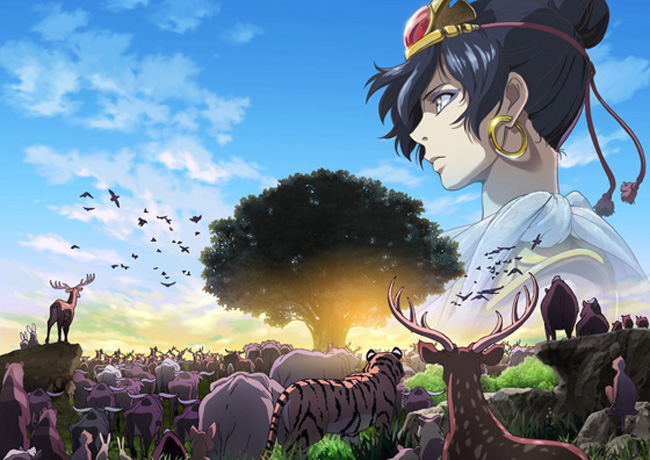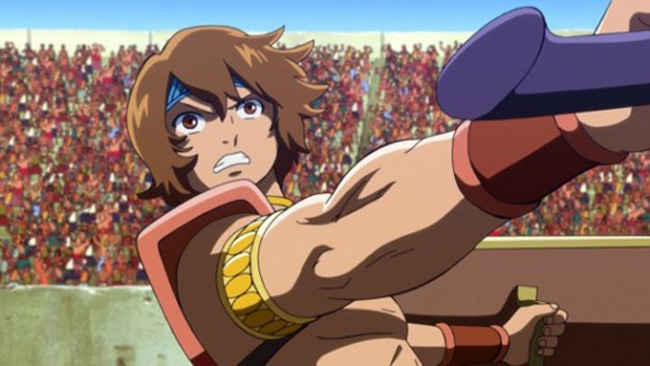
This year’s New York Asian Film Festival was graced with the North American premiere of a film almost three decades in the making. The critically acclaimed and three-time Eisner Award winning manga, Buddha, from Osamu Tezuka, the “Godfather of Anime”, has been given the big screen treatment from animation house Toei Company. Broken down into a planned trilogy from its fourteen volumes of unique and gritty storytelling spanning Siddhartha Gautama’s birth until his transformation into “the Enlightened One”, this first installment—entitled Tezuka Osamu no budda: Akai sabaku yo! Utsukushiku [Osamu Tezuka’s Buddha: The Great Departure]—is a large-scale epic of revenge, war, friendship, spirituality, and a love for nature only someone as one with the earth as Buddha is could cultivate at such an early age.
Beginning in the Himalayas, we watch the great monk Asita witness a sacrifice on behalf of a small rabbit caught in a blizzard, an event opening his eyes to the knowledge that a power had been created which could one day become the king of the world. Director Yasuomi Ishitô and screenwriter Reiko Yoshida then whisk us away towards the Indian kingdoms of Shakya (a land abundant with nature) and Kosala (aggressive and militant, seeking to conquer the nation), simultaneously telling the tale of two young boys—Siddhartha and Chapra. The former is conceived in very familiar, Christian-like fashion as the Queen of Shakya dreams the God Ganesha entering her body; the woodland creatures announce her pregnancy to the King by huddling around him and preventing the continuation of his hunt due to their powerful presence. The latter is a Shudra—the lowest caste of untouchables, beaten and enslaved—who befriends a supernatural boy that can project his soul into animals named Tatta.
The Great Departure now cross-cuts between the two boys, jumping through time as each grows older inside very disparate lives as part of their two rival kingdoms. Siddhartha (Hidetaka Yoshioka) feels out-of-place right from the start, born into royalty, but never fully understanding his place in his culture. Defaulted into the second highest caste—Kshatriyas—he questions why the holy priests possess power over him as Brahmins and why the Shudras will always be at the bottom. His world is one he cannot reconcile, the power needed to rule as a prince in direct conflict with his pacifism and strong insistence that all creatures deserve a chance to live. The bloodthirsty warrior Bandaka risks to turn the boy into a monster in his own likeness through five years of martial arts training, but while the prince becomes ready for war, his soul could never acquiesce to the killing necessary for victory.

While Siddhartha grows, learns, and wanders from his birthright—a tryst with a Shudra named Migaila the most volatile and eye opening of his quest for self—Chapra (Masato Sakai) paves a much different arc. Already a young boy when the prince is born, he falls into trouble when his mother is threatened to be sold by their master. Tatta, unknowingly responsible for this, helps his new friend retrieve her, becoming a tiger in order to do so. But while this rescue occurs, the Kosala army makes its way towards Shakya with Tatta’s village smack dab in the middle to be destroyed in their wake. Chapra attempts to repay the boy for saving his mother by joining the quest to avenge his slain family. Riding into the Kosala camp on a horse—controlled by Tatta—he comes face to face with their leader. Instead of killing him, though, Chapra apologetically asks forgiveness from his friend, deciding to join the warrior ranks by saving the general and becoming his son to rise above his caste and one day return for his mother and Tatta.
With that, the film progresses towards an eventual clash between the two young men on the battlefield. Siddhartha struggles to break away from his father, his arranged marriage to Princess Yashodara, and his instructor of war while Chapra hopes to earn his place as an aristocrat, the secret of his heritage threatening to ruin both himself and his adoptive father. Through stunning animation rivaling the best Studio Ghibli has to offer, The Great Departure delivers everything you could want in a grand-scale tome of action and adventure. Between Chapra’s competition to become the Kosala’s greatest warrior to the very bloody clash of kingdoms—ending with high body count and little reward—the subject matter is definitely not for Pixar-age young audiences. There is darkness at play, a necessary evil to make the young Siddhartha question his existence and desire to seek truth. It’s through his suffering that he realizes he must leave on a journey towards his own enlightenment before he can hope to inspire others.
The film’s construction keeps its audience riveted in their seats, intriguing with the quick glimpses into the lives of its two heroes. Knowing there are two more films to come, you begin to wonder how intertwined the two will become, a fact that surprises as you discover who in Chapra’s half will continue on to join Siddhartha. Everything both do is rooted in their love—the prince in nature; the slave in family—and it’s a wonderful foreshadow of what Buddha will cultivate in his new religion at Sarnath. Having recently come back from India, visiting where the legend held his famous sermon as well as a journey on the Ganges much like Siddhartha and Migaila do here, I have to admit the subject matter and aesthetic probably resonated more than if I saw it a year ago. The level of detail into the heritage of that country is astounding from the lotus flowers, the peacocks and emaciated dogs wandering about, and the large chasm between upper and lower classes explained by our guides. The film took me back and completely enveloped me in its fictionalized account of history. I can’t wait until the story continues.
Osamu Tezuka’s Buddha: The Great Departure is screening at the New York Asian Film Festival.

